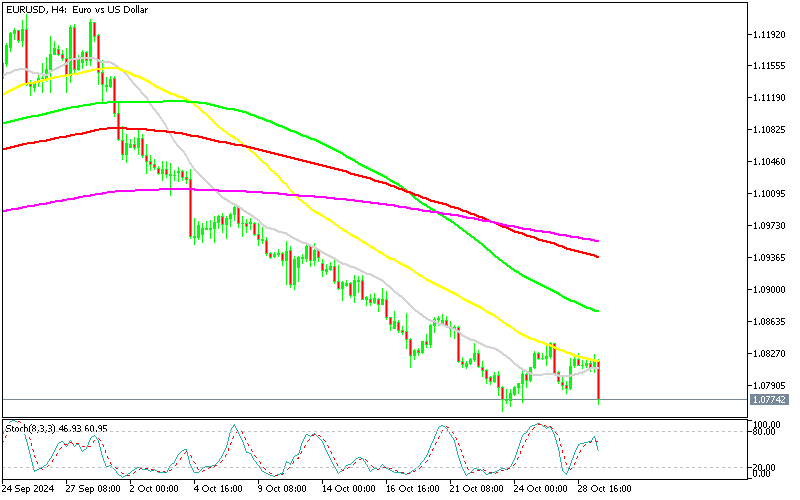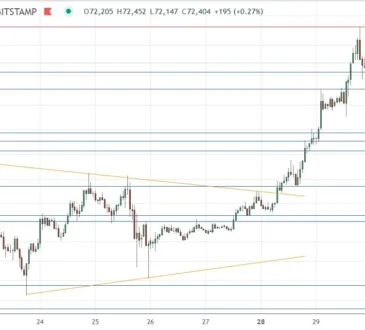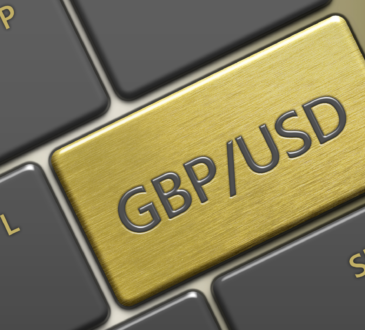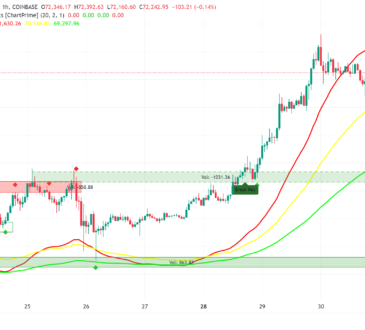EUR/USD Slipped to 1.0761 last week, after relentless selling this month, and the attempts to reverse the decline don’t seem to have much success. We have seen attempts from buyers, but moving averages continue to act as resistance, stopping the bullish moves and pushing the highs lower, which is a sign of further downside momentum.
EUR/USD Chart H4 – Moving Averages Acting As Resistance

After a four-week decline, the EUR/USD exchange rate has stabilized near 1.08. Recent German PMI data for October showed stronger-than-expected performance in both manufacturing and services, signaling that these sectors’ downturn may be easing. Reports indicate slight improvements across manufacturing in Germany and the broader Eurozone, lending a more optimistic outlook for the fourth quarter.
Consumer Sentiment and Economic Outlook
While these developments are encouraging, the Gfk Consumer Climate Index shows a slower recovery for German consumers, who remain cautious after years of economic challenges. The IMF projects Germany’s GDP to remain flat in 2024, following a 0.3% contraction this year. Deutsche Bundesbank President Joachim Nagel, also an ECB policymaker, emphasized the need for Germany’s planned economic growth package to support the economy and prevent further deterioration. This call for action was underscored at last week’s IMF meeting, where Nagel advocated for sustained economic support.
EUR/USD Awaits Key Data Points
In the meantime, the EUR/USD pair remains relatively range-bound, awaiting a series of important economic releases later in the week. With upcoming reports on growth and inflation in both the U.S. and Eurozone, traders are closely watching for signals on potential rate adjustments—factors that could shape the currency’s next move.
German GfK Consumer Climate for October
- Reading: -18.3 points, better than the expected -20.5 points.
- Previous figure: October’s sentiment was -21.2 points, now revised slightly to -21.0 points.
- Implications:
- The improvement reflects slightly growing consumer optimism in Germany as sentiment climbs for the third consecutive month.
- The less negative reading may signal gradual easing of economic pessimism, though sentiment remains deeply in negative territory, indicating ongoing challenges in consumer confidence.
Germany’s latest GfK consumer climate reading shows an uptick to its highest level since April 2022, despite the prevailing economic concerns. Digging into the details, consumer willingness to purchase and income expectations have both improved for the second consecutive period. However, even with these gains, the overall consumer climate remains historically low.
GfK commented on the situation, noting that:
“Consumer sentiment continues to linger at very low levels. The uncertainty brought by ongoing wars, crises, and price increases still hampers the full effect of factors like real income growth that could support spending. Additionally, the recovery in consumer sentiment faces headwinds from rising firm insolvencies and reports of plans to reduce employment or shift production overseas.”
These dynamics point to ongoing challenges for a stronger recovery in Germany’s consumer confidence. However that’s not helping the Euro which has tumbled below 1.08 again today.
EUR/USD Live Chart
EUR/USD





